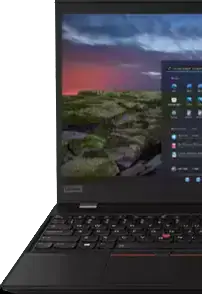What is screen rotate?
Ever wished you could rotate your laptop or tablet's display to read digital content with ease? Well, now you can. Screen rotate is a feature that has become increasingly important for modern device users, as it allows for greater flexibility when using devices. Screen rotation enables users to change the orientation of their device’s display from portrait mode (vertical) to landscape mode (horizontal) and vice versa. This helps facilitate portable recreational activities such as reading e-books, watching movies, playing video games as it allows you to be more comfortable. Screen rotation is typically enabled with an easy toggle switch in the device settings, so users can personalize their experience according to their needs. Screen rotation is quickly becoming a must-have feature on many new devices and gives users endless opportunities to enjoy their media content comfortably.
Additionally, having your device in this orientation also prevents accidental damage due to contact with other objects. Try out the ‘screen rotate’ function today and make your digital reading experience enjoyable and effortless.
How screen rotation boosts productivity for programmers and designers?
Screen rotation is a game-changer for many professionals, especially in fields like programming and design. Here's how it makes a difference:
For programmers
- More visible code: By rotating the screen vertically, programmers can view significantly more lines of code at once. This decreases the need for constant scrolling and improves workflow efficiency.
- Enhanced multitasking: Using varied orientations across multiple monitors allows developers to keep reference documents, terminal windows, and code editors all within easy view. This setup streamlines debugging and development processes.
- Efficient code review: With a vertical screen, it's easier to perform side-by-side comparisons of code changes, which is invaluable during code reviews.
For designers
- Optimized design space: Portrait mode is ideal for vertical designs such as posters or mobile interfaces, providing a better preview and editing space.
- Flexible project handling: Designers often work on projects that require both horizontal and vertical artboards. Switching screen orientations helps them switch focus seamlessly.
- Improved workspace layout: By mixing screen orientations, designers can organize their digital workspace to cater to different content types, enhancing creativity and productivity.
For document processing
- Efficient document viewing: Lengthy documents fit better on vertically oriented screens, making it easier to read and edit large blocks of text.
- Easy comparisons: Differently oriented screens are perfect for comparing documents side by side, which is crucial during editing or data analysis.
Screen rotation isn't just a nifty feature—it's a strategic advantage in professional environments, providing flexibility and control that can drastically improve productivity.
How to rotate a computer screen?
Screen rotation is a useful feature that allows you to view the contents of your device in different orientations. If you want to be able to adjust and rotate your computer screen on command, you will need to know how to navigate the settings on your device. How do you rotate a computer screen? Depending on the type of device you have and what operating system it is running, this may involve altering the angle of your monitor with an actual physical button or handle before accessing a shortcut sequence through the operating system in order to switch orientation.
Using Windows settings to rotate your screen:
For those using Windows, rotating your screen through Windows Settings is straightforward and reliable. Here’s how you can do it:
- Open display settings: Right-click on your desktop and select “Display settings”. Alternatively, you can use Windows search and type “display settings”. For quick access, press the Windows key + I, then navigate to System > Display.
- Select your preferred orientation: Scroll down to find the “Display orientation” section. Click the dropdown menu to reveal four options:
- Landscape (default horizontal view)
- Portrait (rotated 90 degrees right)
- Landscape (flipped) (upside down)
- Portrait (flipped) (rotated 90 degrees left)
- Confirm your changes:A preview of your new orientation will be displayed. Click “Keep changes” to apply or opt for “Revert” if it’s not satisfactory. If no action is taken, the system will automatically revert after 15 seconds.
For example, if you are using Windows 10, you can hold down the CTRL key plus the ALT key plus one of the arrow keys to change orientation. A different approach may be necessary for other systems. However, help is available online should you run into any difficulties. Knowing how to rotate a computer screen correctly can give you a great deal of flexibility with regard to setting up your workspace in whatever configuration works best for getting things done quickly and efficiently.
What are the methods for rotating the screen using different graphics card settings such as Intel®, NVIDIA®, AMD?
When it comes to adjusting your screen's orientation, your graphics card plays a crucial role. Each type of graphics card—whether Intel®, NVIDIA®, or AMD—has its unique method for rotating the display. Let's dive into the specific steps for each.
Intel® Graphics
For those utilizing Intel® Graphics, modifying the display orientation is straightforward:
- Access settings: Begin by right-clicking on your desktop.
- Open Intel® Graphics Control: Choose the option associated with your Intel® Graphics settings.
- Rotate display: Search for the "Rotation" or "Orientation" section.
- Select orientation: Pick your preferred screen rotation and explore the possibility of configuring custom hotkeys for quick access.
NVIDIA® Graphics
If your system is powered by NVIDIA®, you can follow these steps:
- Open control panel: Start by right-clicking on the desktop.
- Navigate to NVIDIA® Control Panel: Select this option to access specific settings.
- Rotation options: Find the "Rotate display" setting within the panel.
- Choose orientation: Decide on your desired screen orientation. For setups with multiple monitors, additional settings may be available.
AMD Graphics
For those with AMD graphics, here’s how to manage screen rotation:
- Desktop shortcut: Right-click on your desktop to get started.
- Open AMD Radeon settings: Select this to enter the graphics settings.
- Display tab: Head to the Display tab.
- Adjust orientation: Look for rotation options and modify as needed. You can also explore further display configurations to optimize your viewing experience.
By following these tailored steps for your specific graphics card, you can easily adjust your screen to the orientation that best suits your needs.
How can I enable screen rotation shortcuts?
If you're looking to enable or personalize screen rotation shortcuts on your system, here's a comprehensive guide that outlines how to do it through your graphics settings.
- Access graphics properties: Begin by pressing a combination like Ctrl + Alt + F12, which commonly opens the graphics properties menu. This might differ depending on your system, so ensure to check your user manual or system help guide.
- Navigate to Hot Key options: Once in the graphics properties, find a section related to "Hot Key Manager" or similar. This is where you can manage and set up shortcuts for screen rotation and other functionalities.
- Enable: Look for options to enable rotation shortcuts if they're inactive. You might see default commands such as:
- Ctrl + Alt + Up Arrow for the standard landscape view
- Ctrl + Alt + Right Arrow for a 90-degree clockwise rotation
- Ctrl + Alt + Left Arrow to rotate 90 degrees counterclockwise
- Ctrl + Alt + Down Arrow to invert the screen orientation
By following these guidelines, you should be able to enable screen rotation shortcuts directly from your graphics settings, providing a streamlined way to switch display orientations as needed.
How can I manage screen rotation in a multiple monitor setup?
Having multiple monitors can significantly boost productivity, provided you configure them correctly. One crucial aspect of this setup is managing screen rotation, allowing each monitor to align perfectly with your workflow needs.
Step 1: Identifying your displays
- Access display settings: Start by navigating to your computer's display settings. This can typically be found in the system settings or control panel.
- Identify each monitor: Use the “Identify” feature to display numbers on each screen and easily distinguish them.
- Select the desired monitor: Choose the specific monitor you want to rotate and ensure all adjustments apply to the correct screen.
Step 2: Adjusting individual monitor orientation
- Tailor each screen's setup: Each monitor can be individually configured, which is perfect for scenarios like having a vertically oriented secondary screen.
- Consider your workflow: Think about the tasks you'll use each monitor for. Vertical setups can be ideal for code editors or document review.
- Optimize desk space: Adjust the orientations to make the most of your available space without compromising comfort.
Step 3: Perfecting the physical setup
- Monitor stand compatibility: Verify that your monitor stands can support the rotation. Adjustable stands or VESA mounts may be necessary.
- Cable management strategies: Re-organize cables to accommodate changes in the monitor’s alignment and maintain a tidy workspace.
- Viewing and ergonomic considerations: Examine the viewing angles and adjust the monitors to avoid neck strain and ensure a comfortable, ergonomic setup.
By following these steps, you can create a customized, efficient, and comfortable multi-monitor environment tailored to your needs.
How to flip a computer screen?
So how do you flip your computer screen from being displayed in the traditional landscape view to a portrait view? This simple feature can be helpful for a variety of reasons, such as reducing eye strain when you're working on an intensive project or watching a movie. Whether you're using a laptop or monitor, learning how to flip your computer screen is quite simple. On most devices, you can use either the key combination of "Ctrl + Alt + Arrow" or press the dedicated keys labeled with either an up/down arrow or an arrow in a circle. Depending on your device settings, you may also need to select the appropriate display rotation settings for optimal results. Once complete, you'll have rotated your computer screen into portrait mode and be ready to optimize your viewing experience!














